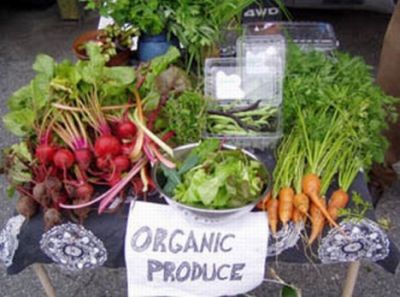Lynn Griffith – Consumer demand for organically produced food continues to grow and provides incentives for U.S. farmers to continue to produce a variety of products. If shopping for organic, you can now find organic products at natural food stores, 3 out of 4 conventional grocery stores, or farmers’ markets. Organic food sales were estimated at $28.4 billion in 2012, and increased to $35 billion in 2014. (1)
As organic food demands increase, there has been seen a growth in the number of farmers’ markets!
 This rising demand for organic food has allowed farmers’ markets to expand. In 2014, there were 8,268 farmers’ markets that provided locally grown organic food to consumers — a 180 percent increase from 2006! (2)
This rising demand for organic food has allowed farmers’ markets to expand. In 2014, there were 8,268 farmers’ markets that provided locally grown organic food to consumers — a 180 percent increase from 2006! (2)
The U.S. Department of Agriculture reported that it’s not just farmers’ markets that are driving the increase sales in local and regional food. More than 4,000 local and regional food businesses and projects, such as food hubs, farm to school programs, and healthy eating initiatives, have all helped to increase locally produced food sales. (3)
The USDA estimates that local food sales have increased from $5 billion in 2008, to $11.7 billion in 2014. (3)
“Local food is rapidly growing from a niche market to an integrated system recognized for its economic boost to communities across the country,” reports, Agriculture Secretary, Tom Vilsack. (3)
Local food is becoming a growing niche market that is a boost to local economies!
Kentucky, Wisconsin, Mississippi, Texas and Alabama are the states that have the most federal investment in local food initiatives. The USDA reports that this investment is paying off with their local food sales. Barbourville, Kentucky has found success in their efforts to expand farmers’ markets into a permanent facility. Clarksdale, Mississippi residents gained support with their vegetable farming job training program, and Fallon, Nevada received support to start a community owned grocery store. (3)
Are local food establishments making it easier for consumers to have access to healthy and affordable food? It appears that the answer is yes! With approximately 6,400 farmers’ markets and direct-to-consumer outlets now accepting SNAP benefits or food stamps, everyone can support and enjoy local foods. In 2014, the federal government put 100 million dollars behind the idea of doubling the value of benefits when purchasing local fruits and vegetables. (3)
Last year, SNAP consumers redeemed approximately $19 million worth of benefits at farmers’ markets! (3)
Whether shopping, eating out or volunteering, remember to support your local farmers by shopping or eating locally, or even taking a day to volunteer at a local farm!
Sources for this article include
(1) www.ers.usda.gov
(2) www.npr.org
(3) www.npr.org
Lynn Griffith is a licensed therapist who enjoys cooking, creativity and enjoys helping other’s learn how to care for their minds and bodies through healthy eating. In the past four years, Lynn has altered her lifestyle and is committed to empowering other’s to have improved self care, mental health, and stress management. Each article and recipe submitted is with the intent to help each person move forward in their journey.
SF Source The Raw Food World July 2015
